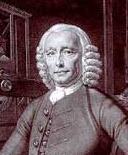 John Harrison
(© Wikipedia)
John Harrison
(© Wikipedia) John Harrison
(© Wikipedia)
John Harrison
(© Wikipedia)
In his book "Concerning Such Mechanism" (as made available by Charles Lucy) the famous inventor of nautical clocks John "Longitude" Harrison (1693 - 1776) describes the mathematical approach he took to create his unique tuning of a diatonic scale. In today's terms, he claims that the logarithm of a whole tone (ratio L) should relate to the logarithm of the octave (ratio 2) like the radius of a circle to its circumference:
Combined with the fact that in a diatonic scale the octave is made up by five whole tone steps (L) and two half tone steps (s):
this permits to calculate Harrison's entire tuning.
To explore the two equations above, they can be generalized as follows:
and
where A is a constant, N is the frame interval of a scale, and p an q are the numbers of whole tone and half tone steps, respectively, in that scale. A slight transformation makes the equations more useful for the calculation of scale parameters:
and
In any Western diatonic mode (N = 2; p = 5; q = 2) there are two different just whole tones: 9:8 and 10:9. This leads to two preliminary values for A:
Averaging them produces
This is so close to 2 · π = 6.28 that choosing
for a Western diatonic mode (Harrison and Lucy) appears to be well justified. The correlated values for the whole tone and the half tone are then:
But it turns out that Harrison's approach is not limited to the Western scale. Any diatonic Bohlen-Pierce mode (N = 3; p = 4; q = 5) features only one just whole tone: 25:21 (301.8 cents). The resulting constant
is even closer to 2 · π than that was the case for the Western scale. The corresponding values for whole and half tone
permit a suitable tuning of a BP diatonic scale, as shown in the table below, with the Lambda mode as an example:
|
|
|
|
|
|
|
|
|
|
|
|
|
|
|
|
|
|
|
|
|
|
|
|
|
|
|
|
|
|
|
|
|
|
|
|
|
|
|
|
|
|
|
|
|
|
|
|
|
|
|
|
|
|
|
Thus Harrison's approach works for BP as well. And it is not limited to scales employing rational numbers as a frame interval, as a look at the 833 Cents Scale confirms. In this scale the frame interval is the Golden Ratio, an irrational number:
The scale features p = 4 whole tones and q = 3 half tones. The whole tones are different: L1 = 1.0821 and L2 = 1.0787. Thus we arrive, like in the Western scale, at two different preliminary values for A:
Averaging them results again in a number that is very close to 2 · π:
The related whole and half tones are then:
As the table below shows, this is an exceptionally close approach to the original scale:
|
|
|
|
("Harrison") |
|
|
|
|
|
|
|
|
|
|
|
|
|
|
|
|
|
|
|
|
|
|
|
|
|
|
|
|
|
|
|
|
|
|
|
|
|
|
|
|
John Harrison, with high probability, would have disliked this scale. But it proves the viability of his basic idea.